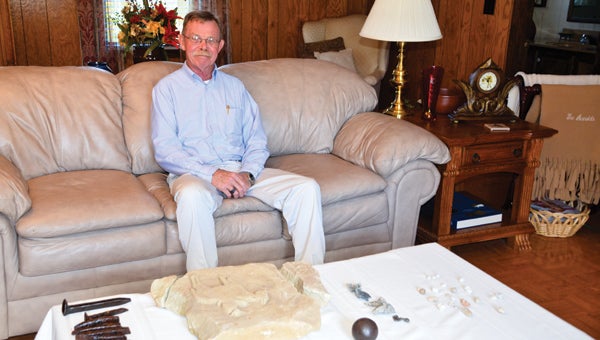
By Emily Etheredge
On an afternoon jaunt in a canoe made out of tin, Wayne Arnold, 12, decided to float down the creek that ran beside his grandmother’s house in Stanton. When his canoe hit a snag in Bogles Creek, Arnold reached into the water to grab a stick that would continue his flow downstream.
As Arnold picked up what he thought was a heavy stick, he looked down and to his astonishment the stories he had read from his school history book became strikingly real.
“It was not a stick, it was a gun,” Arnold said. “The weapon was covered in moss but the gun made me realize that I had found a piece of history that I needed to hold on to.”
Soon after Arnold’s discovery of an 1861 Springfield rifle, he quickly became “the boy who found the gun,” throughout the town he had grown up in and started researching the story that would accompany the piece of history he discovered at a young age.
“History had always been words on a piece of paper,” Arnold said. “It wasn’t until I started finding things near the area where I grew up that history became real.”
History at home
Arnold would soon discover many pieces of Civil War memorabilia from guns, ammunition, buttons from soldier’s uniforms and many other things dating back to the April 1, 1865 battle of Ebenezer Church that took place near property his family owns in Stanton.
The battle took place when General James Wilson advanced his troops toward Selma who were coming from Tannehill, Brierfield and Tuscaloosa. General Nathan Bedford Forrest led the Confederate Army and chose to head off Wilson and his Union soldiers about 25 miles north of Selma in Stanton to give reinforcements time to reach and help defend Selma, but Forrest did not have enough manpower to defend Wilson’s troops.
Forrest was unable to fend off Wilson’s troops and retreated to Selma leaving memories of the battle that lingered in Stanton for decades.
After Arnold found the rifle in the creek near his home he began a quest to discover more items associated with the battle to find out more information about the history surrounding the community he called home.
Now 63, Arnold has researched the Civil War since discovering his first piece of history at age 12 and hopes to educate others on the history of the Civil War with the pieces he has located in Stanton.
“I think when you can pick up something and touch it and trace it back to a point in time that you have read about, it can become real and fascinating,” Arnold said. “For me, I have walked on a lot of ground near my home and my family’s homes that once was a scene of a battle in the Civil War where real people fought and died, and that is an incredible feeling.”
One story Arnold researched was trying to find out why the 1861 Springfield rifle was bent when he found it in Bogles Creek.
After reading different pieces of information and locating Civil War diaries from a captain in the Union army who cleaned up the battlefield documenting the exact artifacts Arnold found, answers to many questions started to surface.
“When the Union soldiers left the area, they bent all of the artillery by softening it in a fire and whacking it on trees,” Arnold said. “They didn’t want Confederate soldiers shooting their guns so they bent everything they left behind to prevent them from ever being used again.”
Another artifact Arnold located was a piece of sandstone found from a southern soldier who carved a mule and initialed the sandstone with the letters “J.S.”
A resident near Arnold’s home was cleaning up an area for his daughter’s playhouse and placed a large rock in front of the playhouse as a stepping-stone inside.
After turning the stone over, it was revealed to have a carved picture on the outside and the neighbors called Arnold to see if he wanted the piece of sandstone.
“This is probably one of my favorite pieces I own,” Arnold said. “When the soldiers weren’t fighting they had a lot of down time and the soldier who carved this picture was probably carving during his down time.”
A portion of the rock is missing with the upper edge displaying what appears to be part of a wagon wheel.
Arnold said he may never know what the soldier originally carved in the sandstone but it appears to have been a work in progress depicting a southern soldier atop a mule.
“For many years this piece of history documenting the Civil War was the stepping stone for a little girl’s playhouse,” Arnold said. “It just goes to show you that things with historical connection can turn up anywhere.”
O.P. McGee
One story Arnold discovered about the battle of Ebenezer Church involved a plantation owner, Oliver Perry McGee and his family who lived in Stanton during the time of the battle.
Arnold said McGee, his wife Annie and two daughters along with two servants Josh and Henrietta were forced to relocate due to the threat of soldiers coming into the town for battle.
The females retreated to a different area and McGee and Josh took their livestock and stayed atop a mountain until it was safe to return to their home.
Once the family returned, Arnold said Union soldiers had turned McGee’s plantation home into a hospital to treat many Union soldiers wounded in battle.
“Many of the doors inside the home had been taken off of the hinges and used for makeshift stretchers for the soldiers to rest on,” Arnold said.
Arnold said after surveying his property, McGee discovered bodies of seven of the Union soldiers near his property that had been left by the Union Army.
“They didn’t bury them, they just left them lying around McGee’s plantation,” Arnold said. “It was the custom back then to just walk off and leave the soldiers if they were shot. There were no dog tags to indicate who had died so it was hard to know everyone that had been wounded in battle.”
Arnold said Annie McGee instructed O.P. and Josh to bury the soldiers even though it meant burying Union soldiers on Southern ground.
“Annie knew these soldiers were the enemy but she wanted them to have a proper burial,” Arnold said.
Instead of placing tombstones along the area where the seven soldiers were buried, McGee planted cedar trees near the back of the cemetery that still stand today.
Arnold said a monument was erected on November 11, 1977 to signify Union soldiers buried on Southern soil.
The cedar trees still stand in the cemetery near the monument.
“The story shows the character of Annie McGee who wanted to give the soldiers a proper burial,” Arnold said. “She recognized the humanity that these men deserved to be buried and wanted to respect them even though they had ransacked her home.”
Preserving the past
Arnold has acquired information spanning several decades of his life that he now shares with people throughout his community of Stanton and Maplesville as well as anyone interested in the Civil War.
“I enjoy telling people about the history that happened near my home,” Arnold said. “People will come and visit me and I will take them to the areas of the battlefield and show them some of the things I have found. It is one thing to read about something but another thing to actually walk the area where soldiers battled.”
Arnold said he has spent money on high-tech metal detectors to locate some of the memorabilia from the war but most of the items found were by walking and scouring the sites with his eyes.
One day, Arnold hopes the town of Maplesville will expand the picture museum currently open to a historical museum where he would donate some of the items he has found over the years for people to learn about.
“I know I won’t be around forever,” Arnold said. “I think there are a lot of people out there who have stopped caring about history and in some ways all of the things that I have found throughout the years will one day be lost to people. I hope that the stories and the artifacts I have found will mean something to someone so a museum would be wonderful.”
Arnold said the biggest challenge with history is locating accuracy and preserving that accuracy for the future.
“History is a tricky thing,” Arnold said. “People remember things as they want them to occur, not as it actually occurred.”
Arnold said in many ways he didn’t discover history as a young boy floating down a creek near his home but history found him.
“I have always been the boy who found the gun and I knew when I found that gun that it was my job to locate the story behind what I had found,” Arnold said. “When I found that particular piece of history it was up to me to do the research, and I have devoted the majority of my life to understanding the stories of an era that helped make the area I call home, a home.”
